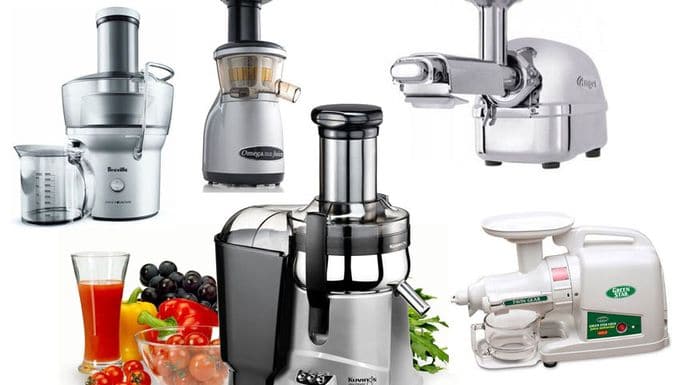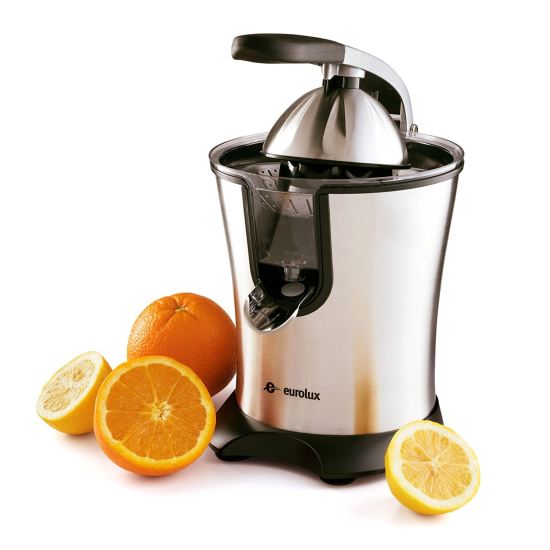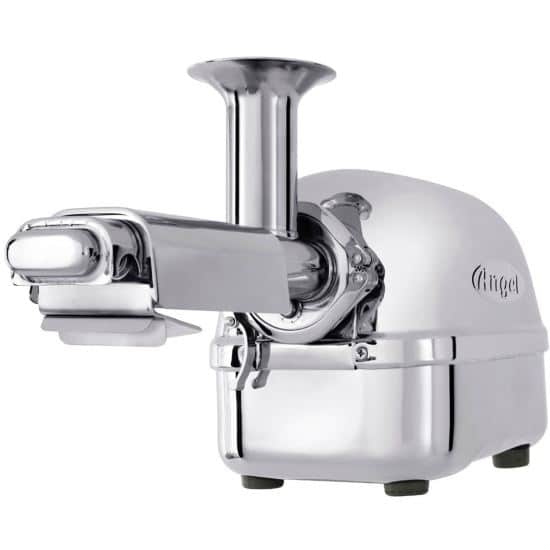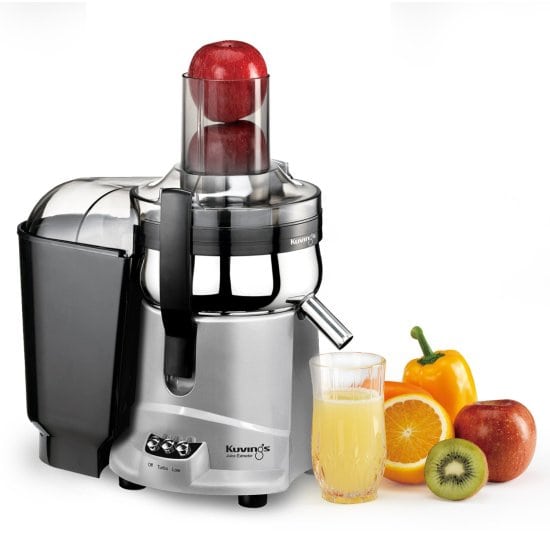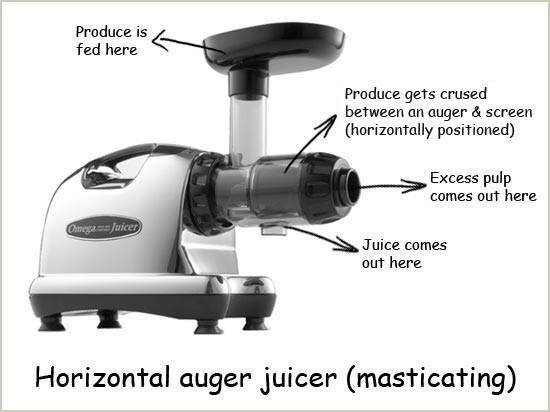Juicers are very popular among consumers because of the high popularity of fresh juice. Today, companies in abundance offer models with different functionality that depends on the type, design and technical characteristics of the model. Of course, this criterion is one of the most important when choosing the optimal model.
Operation principle and functionality
Juicers are divided into manual, mechanical and electrical models.
Hand models are the most simple, reliable and cheap. Low efficiency and the need of significant physical effort are the main drawbacks.
Hand model for citrus is a plastic or metal cone. The fruit are cut into two parts. Juicing is performed with the help of manual pressing with scrolling. Models with a piston use the principle of press.
The mechanical models are made of steel or cast iron. They provide higher efficiency due to a special design. The lever is a mandatory attribute of all mechanical models. Mechanical juicer is a typical example of these devices. Replacing the standard screw on the conical nozzle transforms a meat grinder into juicer.
Electric models are equipped with an electric motor. They provide maximum efficiency that reaches of 75-95%. Of course, these models are significantly more expensive compared to hand or mechanical juicers.
Juicers are divided into household and commercial devices.
Household models provide juicing in a small amount. They have a low power and low or average performance.
Power, performance, efficiency and cost of professional models are significantly higher. They are designed for use in cafes, restaurants, bars and other similar establishments. The professional juicers often have a stylish design.
Industrial models are very expensive, have large sizes and maximum performance. They provide industrial scale of juicing.
Modern juicers provide efficient juicing from citrus, hard vegetables and fruits, stone fruits and even herbs. Models of the lower price range are usually highly specialized. More expensive models are universal.
Citrus juicers
They are intended for juicing from oranges, tangerines, grapefruit, etc. The presence of highly specialized models is caused by low efficiency juicing from citrus with the help of conventional models.
Citrus are ideal for juicing due to softness of the fruit. Watery structure and the absence of solid components provide an effective juicing even by hand models.
Electric citrus juicers are divided into screw and centrifugal (rotary) models. Their motor usually have low power (30-40 W) that is enough for soft lemons, tangerines and oranges. Centrifugal models have lid for fixing and indentation fruit into disk-cutter.
Hard fruits and vegetables, and stone fruits
These juicers are more powerful. Motor power affects the cleanliness and transparency of juices from apple, squash or carrots.
These models are additionally equipped with a rather complex filtration system for separation of juice from pulp.
They often have a conical or cylindrical sieve for pre-grinding of hard fruits and vegetables that significantly increases an juicing efficiency.
Such berries, as a currants, gooseberries, chokeberry, sea buckthorn, etc. are classified as stone fruits.
In this case, the juicing process is very complex due to instant clogging the grid cells. This task is effectively solved with the help of screw models with large bushing. Such device squeezes out the juice from berries and deletes bones.
Universal model
Expensive universal models are designed for juicing from fruit, berries, vegetables, nuts, and even herbs. In fact, these models are analogous to a food processor with the functions of shredding and blender.
Modern universal models often have additional features including froth suppression, automatic cleaning, etc. Accordingly, such universal models are more expensive.
The design of universal centrifugal juicer is more complex compared to citrus or screw models. Initially mechanism crushes the fruits, and then directs them to the separator. Such devices produce more juice, but it contains more pulp.
Juice consistency and device performance are significantly depend from filtration system. For example, juicer with a cylindrical filter provides up to 95%, but it requires manual cleaning after 3-4 glasses of juice. Effectiveness of model with a conical filter is less on 15-20%, but filter is clogged significantly less.
Centrifugal (rotary) juicers
Of course, centrifugal models have maximum versatility. For example, they have rotating knife for grinding. Almost all modern models provide rotation speed adjustment of blades.
Rotating knife provides pre-grinding ingredients inside the centrifuge. Then the juice moves in the direction of walls by centrifugal force and gets on the filter. The filter separates it from the pulp. The juice after filtration is directed into container or glass.
The filter regularly clogs during work and requires cleaning. This complicates the work, especially at the cooking a large quantities of juice. Automatic separation and ejection of pulp greatly simplifies this process. More expensive models often have this function.
Masticating juicers
Many juicers with auger are hand or mechanical and have a relatively low cost.
Auger performs the function of press. It presses the juice from pre-cutting fruit. Such models have one or two augers. Efficiency of models with two augers is much higher. They use the principle of cold-pressed. The ingredients are placed between rotating screws. Their rotation speed is very low.
Electrical masticating models belong to the universal class and work as automated mechanism for pressing. They have a much smaller engine power (150-300 W) compared to 800-1000 W in the centrifugal models. The motor is equipped with reliable protection against overloads. Juicing process is carried out at a rotation speed of 40-80 rpm. In this mode the finished juice retains a maximum of useful substances, and the noise level is very low.
These devices are divided into horizontal and vertical models.
Horizontal model uses a pusher. These models well squeeze out the juice from greens and grains, but are less effective for fruits and vegetables. Vertical models provide automatic shredding, a fruit supply into screw and are more versatile.
Performance of centrifugal and masticating models is about the same.
Pros and cons
Today the popularity of masticating models increases compared to centrifugal juicers due to several factors:
– possibility of juicing from stone fruits and greens. Using such fruits is impossible in centrifugal models due to risk of disc damage and instant filter clogging;
– minimum rate of juice oxidation due to minimal contact between air and juice and lack of heating in juicing process. Oxidation significantly reduces the useful properties of juice.
But masticating models also have disadvantages:
– auger is effective mainly during operation with hard fruits. The juice from soft varieties of apples and overripe fruits is obtained only in the form of puree;
– models often require pre-grinding the vegetables and fruit;
– the cost of such models is higher compared to centrifugal models;
– many models are calculated approximately 20-30 minutes of continuous operation. Then juicer automatically turns off due to engine heat.
This video offers review of the most popular models 2019.
